This holiday season I visited Christmas markets in the Alsace region of France. Besides a few extra pounds of weight, I brought back a deeper understanding of Alsatian markets, food, and culture. I look forward to sharing my impressions in two parts. This one is focused on the Marchés de Noël in Strasbourg. The second part is devoted to towns along the Alsace Wine Route, particularly Colmar and Riquewihr.

Strasbourg’s Christmas market is often cited as the oldest marché de Noël in France. That’s true, but as a technicality. The custom originated in Germany, and Strasbourg’s Christmas market was first held in 1570 when it was part of the German empire. (The Alsace region has flipped between German and French nationality four times in fewer than 150 years.) When Alsatians fled during wartime, they took their traditions with them. Christmas markets are now prevalent throughout France.
Christmas markets are different from typical open-air markets. The air is perfumed with aromas of cinnamon and clove. Foods aren’t the standard ones you find at markets, but rather seasonal treats that elevate the holiday meals into something special, such as foie gras, pain d’épices (a medley of ginger, clove, cardamom, anise, and other spices), bredele (biscuits that were originally made with leftover bread dough, hence the name), menele cookies in the shape of St. Nicolas—a special treat for children—marrons glacés (glazed chestnuts), and cakes topped with powdered sugar like freshly fallen snow.

pain d’épices at Mireille Oster market stall
Some specialties such as kougelhopf and Munster cheese are available all year. Turban-shaped kougelhopf cakes are said to have originated in Vienna but have been embraced by Alsatians. Asked when they typically eat it, the answer is that kougelhopf goes with everything at anytime.

kougelhopf topped with almonds
Alsatian Munster cheese is the real deal and not to be missed. The washed-rind cheese is made from the milk of cows that have been grazing in the Vosges. It surprises with its earthy barnyard smells. It’s smooth and super delicious—nothing like American muenster cheese which is a bland, machine-processed, bastardized imitation.

“munster fermier” signals a flavorful, farmhouse-made cheese
As with any good market, there’s plenty of food to be eaten on the spot. Warm potatoes drizzled with cheese. Chewy soft pretzels called bretzels. To wash everything down and stay fortified from the cold, there’s plenty of vin chaud (hot-mulled wine). Although typically that’s made with red wine, in Alsace—an area known for fruity white wines– you have your choice of red or white vin chaud.
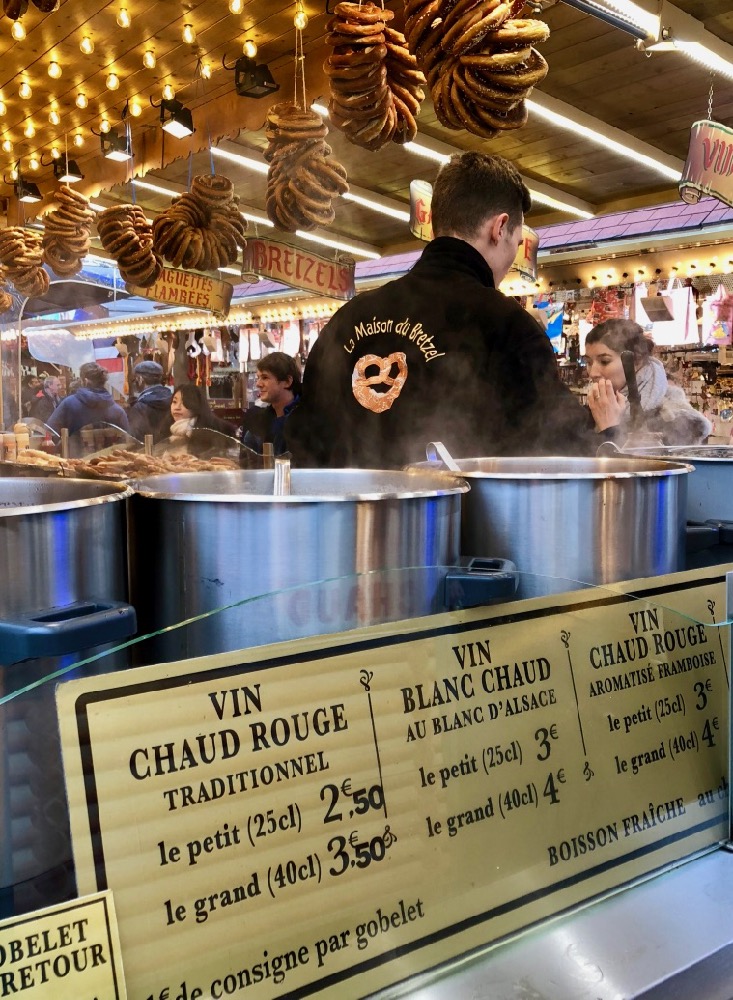
Some of the best souvenirs to buy at Christmas markets are ornaments. Red balls recall an old local tradition of decorating Christmas trees with apples. After a particularly bad harvest, the apples were replaced by glass red boules.
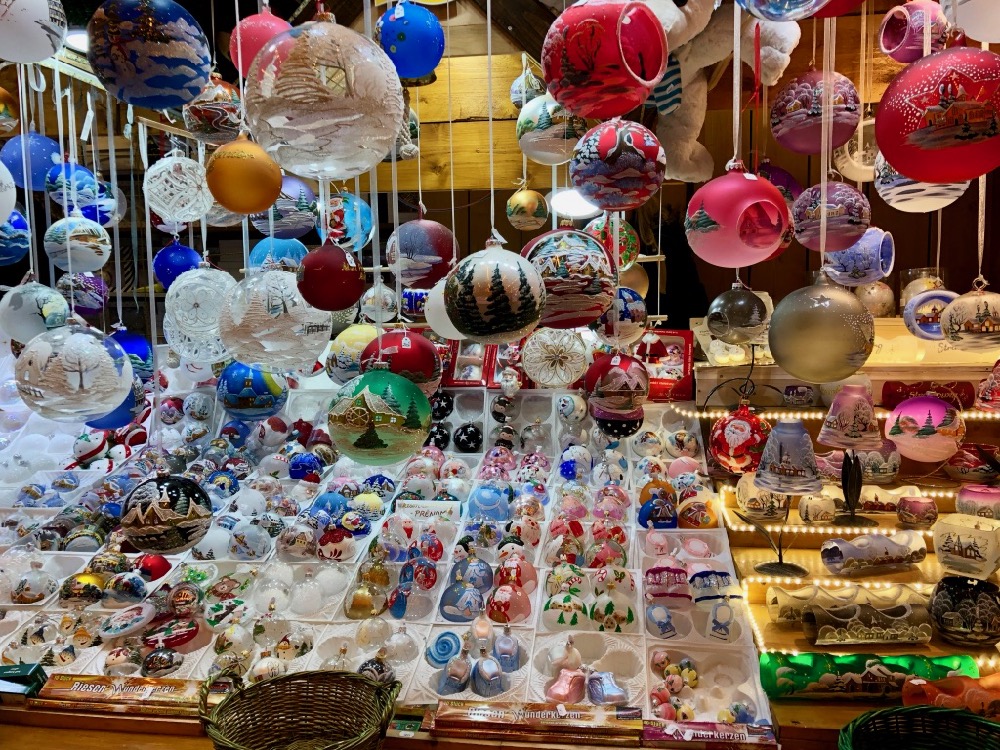
There are rosy-cheeked Santas, angels made of straw, and storks.

Storks and angels are part of the local lore
Santons, a Provençal craft, are also represented.The figurines practically beg to be touched to appreciate the pointed noses, smooth folds of clothing, braided basket handles.

Santons are a Provençal craft and tradition
Linens are decorated with folkloric motifs, although generally not produced locally anymore. Artisans sell handsome pottery.
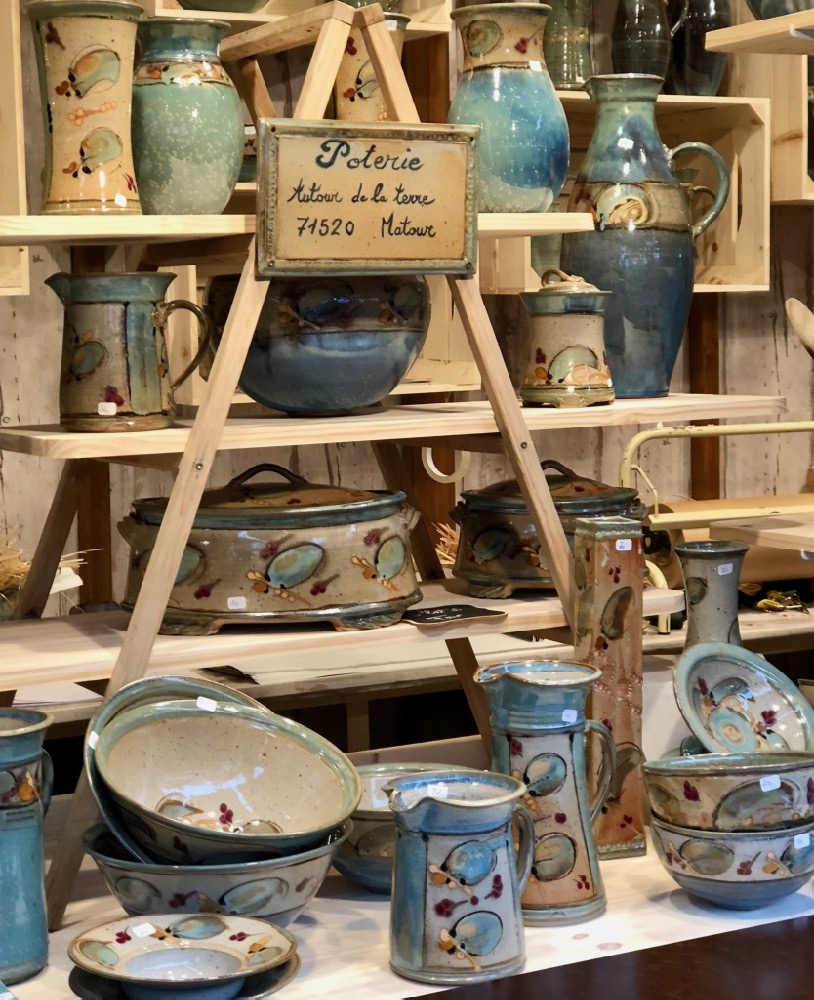
What really sets the Christmas markets in Strasbourg apart from the usual markets (and from many Christmas markets elsewhere) is their ambience and decorative allure. Each neighborhood takes on a distinct personality. Lacy curtains of white. Stars dangle as if constellations are within reach. Shopkeepers go all out decorating their storefronts. Vendors spruce up their chalet huts with evergreens and twinkling lights. When darkness arrives, lights flip on and the mood is most cheerful.

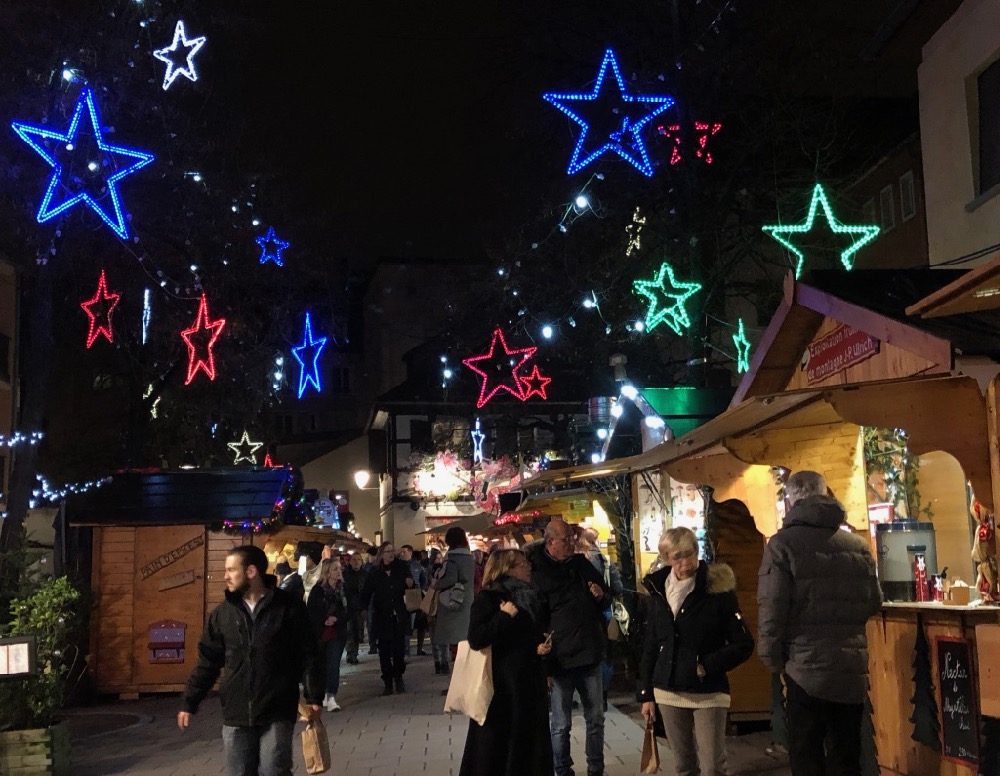

Christmas markets are entertainment for the whole family. There are free concerts throughout the Advent season plus street musicians who add to the festive beat.
Since its beginnings in 1570 when local craftsmen sold goods near the main cathedral, Strasbourg’s Christmas market has expanded into 11 markets on the Grande Île surrounded by the river Ill. It’s very walkable, maybe 20 minutes from end to end, with plenty of reasons to linger along the way. There’s also a tram that circles for those who desire automated transport.
The market at place de la Cathédrale has the advantage of the backdrop of Nôtre-Dame cathedral with its tall spire that pierces the clouds and a massive six-petalled rose window.
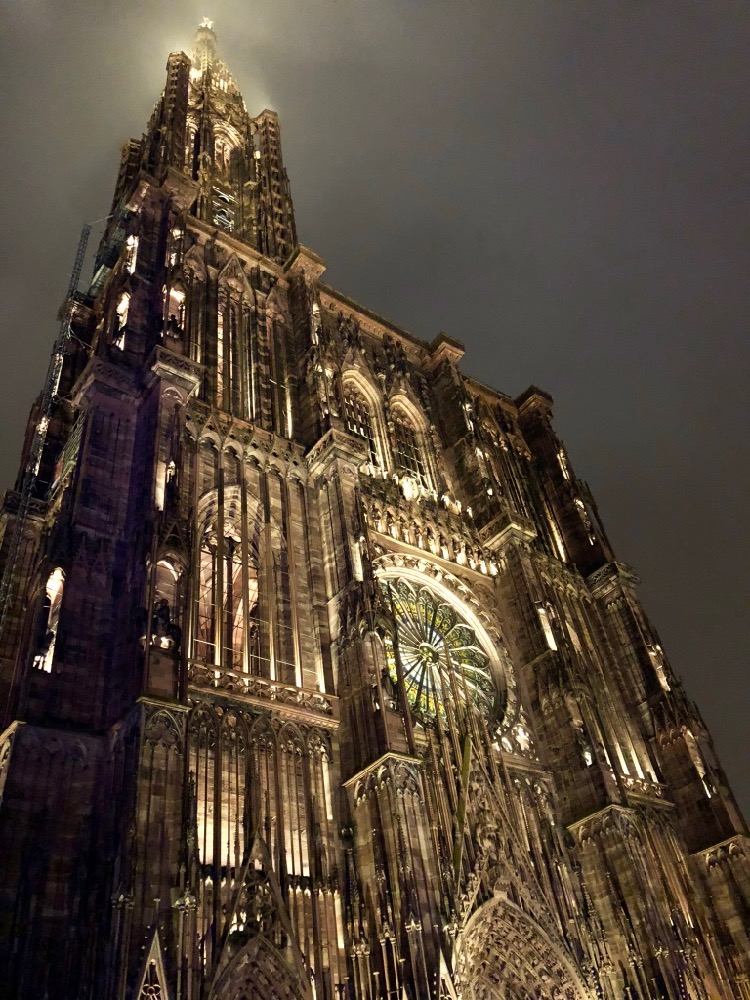
Nôtre-Dame Cathedral in Strasbourg
The market at place Broglie, which reclaimed the name “Christkindelsmarket,” is the biggest of Strasbourg’s Christmas markets.

The market at place Kléber distinguishes itself with a massive Christmas tree which attracts camera-toting tourists like moths. The square is dotted with stalls whose proceeds go to worthy causes.

Place Kléber
In place Gutenberg, a bevy of blue lights creates a surreal haze. That market takes the theme of a different European country each year—aptly so since this is where the Committee of Ministers of the Council of Europe resides.

Place Gutenberg
In Petite France, formerly the tanners’ quarter, the markets are near canals. At place des Meuniers, local producers sell wine, beer, mustard, and cheese. At place Benjamin Zix, the Meisenthal stand is notable for its high-quality glass ornaments. One of the few remaining glass blowers in the area, their ornaments are authentically local. They add a new style each year.

Meisenthal glass ornaments
The convivial “Off” market, only a couple years old and still getting its footing, is more experimental in its composition of vendors and its market stalls which are fashioned out of railroad containers.
Once you’ve had enough of the markets, there are many indoor establishments offering refreshment. Christian, known for chocolates and patisseries—and, especially during Christmas season, it’s fanciful exterior—has a tea salon.
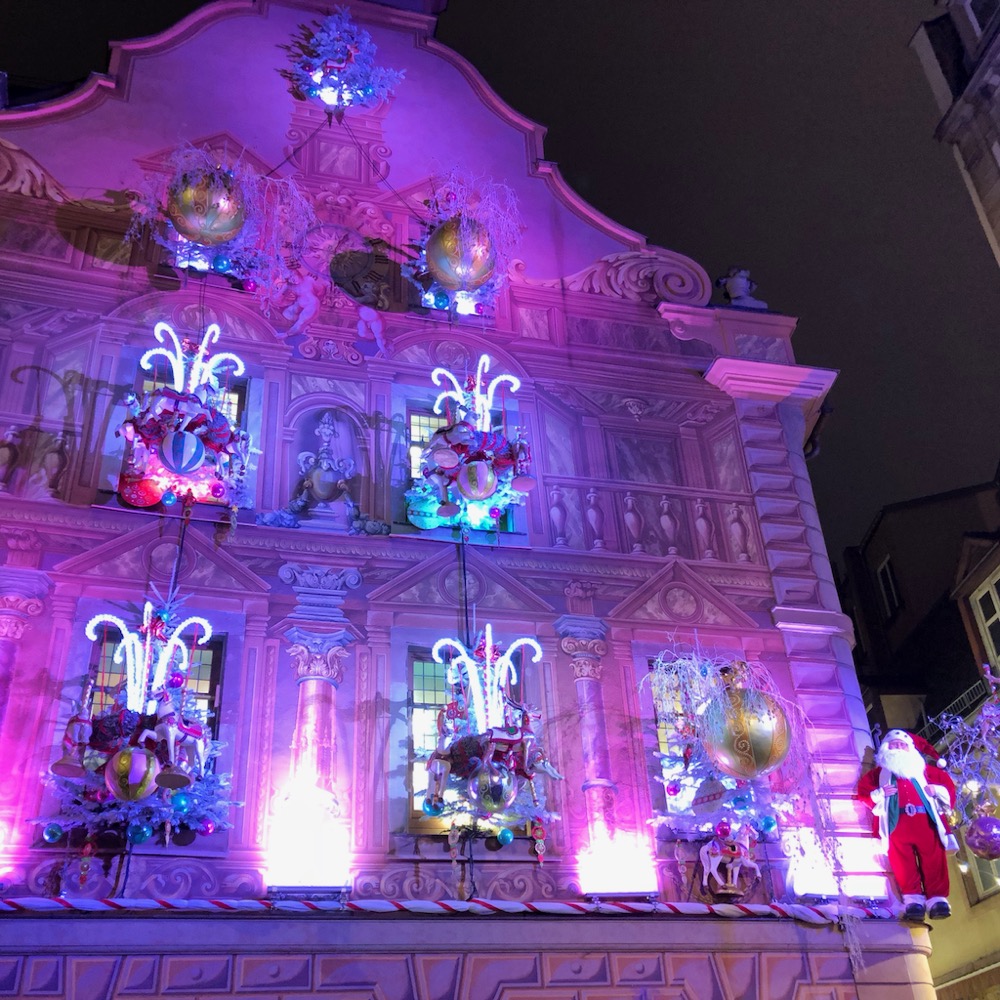
Christian storefront during Christmas
Cozy pubs known as winstubs are a choice way to sample the local culture. They serve good local wines and simple hearty fare such as tarte flambée (like a thin-crust pizza with cheese and lardons) or pungent choucroute garnie topped with pork. If in the mood for a more elegant meal, Strasbourg has many fine restaurants. I enjoyed dinner at Le Casserole where the dishes are inventive and well executed. Maison Kammerzell attracts notice with its 16th century half-timbered architecture. Its restaurant, a touristy spot, serves Alsatian choucroute (sauerkraut) with three fishes (salmon, haddock, and pike).

tarte flambée
Strasbourg has numerous attractions besides Christmas markets, but those were my focus. It’s fun to enjoy the shortest days of the year among friends and friendly strangers surrounded by dazzling lights and decorations, good food and wine, and immersed in a local culture with many colorful traditions.
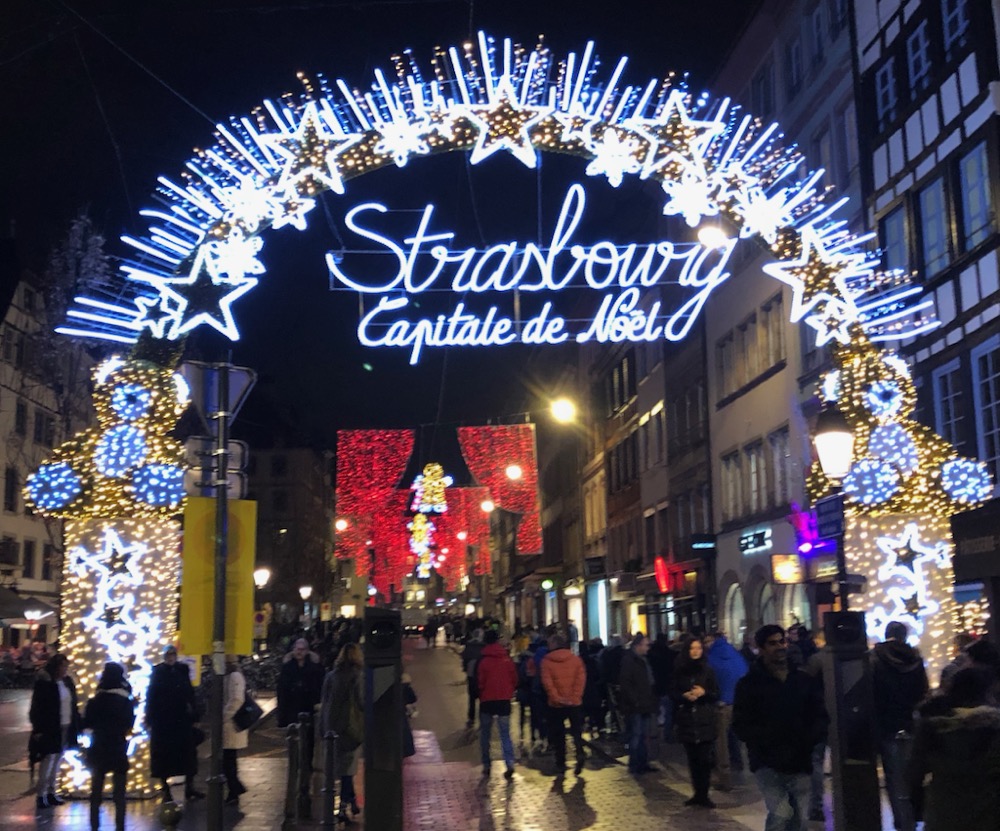
Details:
- Strasbourg’s Christmas markets open at the end of November and continue through Christmas Eve. Hours are 11 am to 8 pm weekdays and until 9 or 10 pm weekends.
- The Office of Tourisme can provide a map and other useful information. Website: noel.strasbourg.eu
- Strasbourg’s regular outdoor market is Wednesday and Friday mornings at place Broglie, however it moves to place Kléber during Christmas season.

16 comments. Leave new
Hi, Do you know if the christmas market would still be open on 26 Dec till New Year Eve? While the official website noel.strasbourg.eu did state that the markets in Strasbourg will be open, only very few stores would be opened post Christmas based on past years, according to other online sources. What about those in Colmar, Basel and Freiburg? Anyone knows whether they will be opened post-Christmas?
The Marchés de Noël in Strasbourg are at their fullest and liveliest in the weeks leading up to Christmas from late November until Dec 24. They close on Christmas Day. From Dec 26 – 30, portions of the Noël markets are open but the options are more limited. As for the other towns, I recommend contacting the Offices of Tourisme to see how each handles it.
We are planning a trip late November from Canada and this has helped so much. Thanks for the detail and the lovely pictures.
I’m happy to hear that. Have a wonderful trip!
Marjorie, Loved your article on Strasbourg and all its glorious markets. We’ve never been, but it’s on our list! Your photos made us want to go all the more! Merci!
Thanks, Betty. It’s easy to get there from Paris. You’d enjoy the markets, foods and wines, the whole experience!
Great article. We really feel the atmosphere of the place.
Thanks, Audrey!
This is a marvelous article–chock full of cultural tidbits for francophiles like me.
I’ll share it with local French students in whose class I volunteer.
Thanks for the feedback. I would be interested to learn your students’ reactions.
Such good information for enjoying the Strasbourg market at Christmas. It is definitely on my bucket list!
Glad to hear it! It was on mine too 🙂
Excellent review! I really enjoyed reading it and your detail.
Thank you!
Thank you, Karen. It means a lot to receive your feedback.
Totally wonderful post!
Mille mercis.